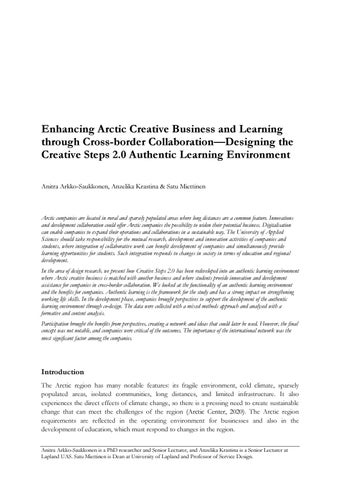Enhancing Arctic Creative Business and Learning through Cross-border Collaboration—Designing the Creative Steps 2.0 Authentic Learning Environment Anitra Arkko-Saukkonen, Anzelika Krastina & Satu Miettinen
Arctic companies are located in rural and sparsely populated areas where long distances are a common feature. Innovations and development collaboration could offer Arctic companies the possibility to widen their potential business. Digitalisation can enable companies to expand their operations and collaborations in a sustainable way. The University of Applied Sciences should take responsibility for the mutual research, development and innovation activities of companies and students, where integration of collaborative work can benefit development of companies and simultaneously provide learning opportunities for students. Such integration responds to changes in society in terms of education and regional development. In the area of design research, we present how Creative Steps 2.0 has been redeveloped into an authentic learning environment where Arctic creative business is matched with another business and where students provide innovation and development assistance for companies in cross-border collaboration. We looked at the functionality of an authentic learning environment and the benefits for companies. Authentic learning is the framework for the study and has a strong impact on strengthening working life skills. In the development phase, companies brought perspectives to support the development of the authentic learning environment through co-design. The data were collected with a mixed methods approach and analysed with a formative and content analysis. Participation brought the benefits from perspectives, creating a network and ideas that could later be used. However, the final concept was not notable, and companies were critical of the outcomes. The importance of the international network was the most significant factor among the companies.
Introduction The Arctic region has many notable features: its fragile environment, cold climate, sparsely populated areas, isolated communities, long distances, and limited infrastructure. It also experiences the direct effects of climate change, so there is a pressing need to create sustainable change that can meet the challenges of the region (Arctic Center, 2020). The Arctic region requirements are reflected in the operating environment for businesses and also in the development of education, which must respond to changes in the region. Anitra Arkko-Saukkonen is a PhD researcher and Senior Lecturer, and Anzelika Krastina is a Senior Lecturer at Lapland UAS. Satu Miettinen is Dean at University of Lapland and Professor of Service Design.














